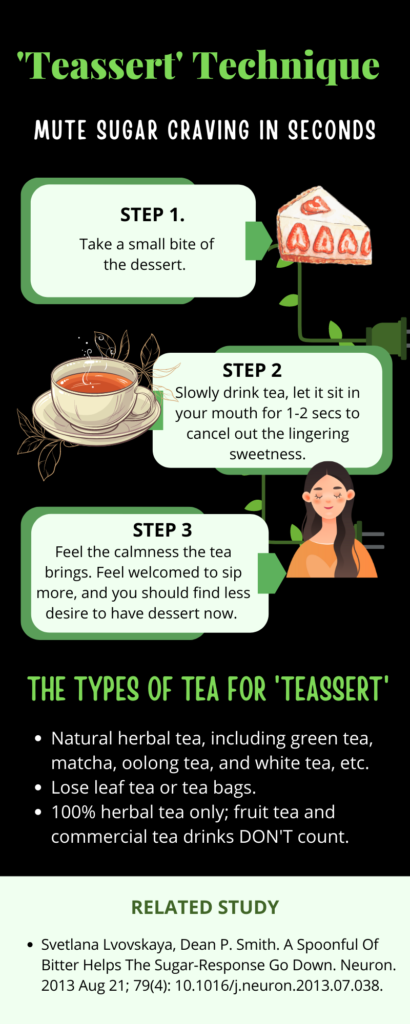When I first came to the US, I was facing not only seismic cultural shock, but also physical shock as well. The first time I ate an ice cream cone on US soil, I couldn’t swallow it. Gosh, it was too sweet for me to handle. Right after the first bite of it, I threw it away.
My American classmate saw me confused: ”It’s an ice cream,’ she said. However, the aftertaste and content of the over-sweetened cream kept me sick and nauseated for days.
One month later, because of all the social events I attended and the desire to blend in with others, I encountered many desserts. I also learned to accept them. My initial reaction to the sugary substances subsided. And I could chew the ice cream without feeling something wrong about it. The ice cream, chocolate cakes, carrot cakes, syrups, and all other types of sugar started to feel delightful. Three months later, they became my addiction.
Don’t get me wrong, in China we have desserts. We have many desserts throughout all of Asia. But in my experience, very few of them tasted nearly as sweet as the ones in the US.
This was later confirmed by friends I made in the US who are from South Korea, Japan, Vietnam, and other parts of China. This experience flashed in my life again in 2018 when my parents visited the US. I took them to a great local restaurant on the day they arrived. I ordered the same dessert for each of us. But my parents, after tasting a bit of mine that came early, decided to share only a small portion of the slice I had. “It’s way too sweet!” My mom exclaimed. Then she drank almost 16 oz of water to dilute the aftertaste of sugar. These cakes — as I’ve learned after living in the US for years — are a normal sweetness here.
If you are born and raised in this country, you probably have no idea how desensitized towards sugar your taste buds have become. Here are some numbers to put things into perspective:
According to Euromonitor International, the average American eats 126.4g of sugar per day. That’s close to FIVE times the amount eaten by an average person in China (28.3g). Meanwhile, the American Heart Association recommends a woman to have 25g sugar a day, men 35g. Even by American standards, it’s way out of line.
Over-consumption of sugar has finally led to a collective anti-sugar movement around the nation. Everyone is afraid of sugar now. The sentiment towards sugar had an extreme shift, but the addiction stayed. This paradox is the predicament you are living day in and day out.
In this sugar addiction treatment guide, I share four truths about sugar addiction and ways to curb it. I’ll also share a powerful technique that can stop your hunger for more sugar in seconds.
Your Sugar Addiction Treatment Guide
Truth #1. Your taste buds are like muscles, they are very trainable.

Remember when I first came to the US, a normal ice cream was too sweet to swallow? Yet, it was only in a few months my sugar tolerance became Americanized.
If my parents stayed in the US for longer and ate more desserts, they would have adapted too. (Both of them refused to have more desserts as they felt physical discomfort from them.)
You’ve been through a similar adaptation process without realizing it. Most likely, it started during your early childhood before you were aware of it.
Whenever something great happened, you ate an ice cream to celebrate. Whenever something sad happened, you found comfort in chocolate. Sweetness was everywhere.
Your brain feels rewarded as sugar triggers dopamine. Your desire for that instant pleasure expands unchecked. And finally, your taste buds, sugar-saturated, become numb.
Here’s the great news:
Like you’ve trained your taste buds to prefer heavy doses of sugar, you can train them to prefer smaller doses of it.
Here’s an amazing thing about retraining your taste buds:
When too much finally tastes like too much, sugar addiction is gone. And over-sweetness, instead of being delicious, becomes unpleasant.
This alone would solve the problem if the sugar addiction you are experiencing is only on the taste bud level. But in most cases, this sugar addiction has deeper roots. We’ll discuss them in the following sections.
|
For someone who overeats sugar only due to the love of its taste, this is the end solution. Take the gradual approach, don’t cut sugar off completely as it triggers self-deprivation. The key is rewiring your taste buds’ preferences without triggering greater psychological hunger. |
Truth #2. Your brain chemistry creates your reality.
Most chronic sugar cravings are partially neurological. By that I mean it’s there because of a chemistry pattern that was established a long time ago.
I want to make it as easy and intuitive to understand as possible, so let me break it down for you this way:
Imagine you are holding a fat juicy lemon in your hand. I want you to quiet your mind and visualize this lemon.
Now you’ve created a vivid image of it in your brain. As this image forms, your brain retrieves all impressions it has gathered on the look and feeling of this lemon. The softness, richness, flavor, chubbiness, fluffiness, and juiciness come to you all at once. And the next thing you know: you are salivating.
Your imagination is a neurological reality to the brain. When you imagine, your brain simulates it as if it’s reality. And your physical reaction is a part of that simulation your brain projects.
So if someone hands you a lemon at this moment, you’d grab it because it fulfills that neurological reality.
And feeling the need to materialize what your brain projects is what craving is all about. That’s exactly how sugar craving happens. And cravings, when suppressed, can become addictions.
Emotions and Cravings
Emotions also play a huge role in this process. This is because they are direct translations of the chemical reactions within the brain. For example, there are hormones we call ‘happiness hormones’ such as dopamine and serotonin. And there are also the ones that we call ‘stress hormones’ such as cortisol and CRH.
So when you associate certain emotions to eating sweets, your brain chemistry drives you to fulfill the cause through action. And if you don’t do it, you feel discordance within. This applies to emotional eating in general.
Understanding the role emotions play is a huge distinction experienced by my clients. It shows them that by being attentive to their emotions, they can re-engineer their brain chemistry and shift away from the craving patterns.
For my Lean Instinct Formula™ , we have a fine-tuning process dedicated to that result. Clients see significant changes once they’ve applied it. The results: what used to be the worst addictions now feel as neutral as the air. And their appetite is no longer governed by their emotional circumstances.
Many people try to fight sugar addictions by banning sugar. They usually fail as they don’t address the chemical and emotional drivers in the backseat.
Truth be told, the best way to stop an established pattern isn’t to kill it. Instead, it’s to create a new pattern that leads the brain to a much healthier, joyful satiation. Sugar creates seconds of happiness. However, there are many replacements for longer and higher-quality happiness. As the new pattern becomes dominant through the fine-tuning process that I mentioned, the old pattern of addictions becomes the past.
Truth #3. Your body is resisting your goal.

If you’ve been trying to lose weight through various methods, but haven’t been successful, your body is likely preventing solutions. Constant sugar craving is a part of its malfunctioning.
There are various hormones that affect sugar cravings, such as:
- Estrogen
- Progesterone
- Appetite hormones such as insulin, cortisol, dopamine, leptin, and ghrelin.
- FGF21 which controls energy balance, insulin sensitivity, and energy balance.
Meanwhile, many overweight people have chronic inflammation. One of its many consequences is the impact on hormonal balance (again, chemistry!)
Here’s the main message:
If your body is primed to work against you (hoard calories, over-consume stress, trigger restlessness, create hunger, and amplify cravings, etc.), you are facing an upward battle on every front.
That’s why when I’m coaching my clients, this is the very first thing that we solve. When it’s solved, they see fast progress in both losing weight and removing sugar addiction. In fact, these two happen as the guaranteed byproduct of the change in their core.
Truth #4. In many cases, cravings are perceptions.
I’m specifically talking about purely psychological cravings here.
It’s the situation where you pass by Dunkin Donut, think of a Boston Cream, and immediately enter to grab one as you think you are craving it (whereas you only had a thought about it).
You just didn’t differentiate a thought from the real craving.
Here’s a simple truth that a lot of us have never realized:
Psychological cravings don’t start when you think of the Boston cream. Instead, they start when you acknowledge that thought as a craving.
In other words, you turn the thought into a craving only because you assume it is.
And what happens when the word “craving” pops up in your mind? You immediately start resisting it. This creates the self-deprivation sentiment. The more you feel deprived, the more you want it.
Now, craving is real.
Yet if you’ve left that initial thought as it was, it would’ve had no power over you.
This is a classic process of people turning perceptions of cravings into real cravings.
Your initial craving is perception. You add a conviction to that perception. Your conviction brings up emotions. Your emotions trigger the cravings.
What does it mean?
It means it’s your choice 100%.
Does the picture feel a little blurry to you? Let me share with you a story to help show you the nature of psychological cravings:
Years ago, there was a BBC documentary series about the psychology behind obesity. Here’s a fascinating experiment included in the documentary:
Twelve pairs of twins participated in a study about cravings. They were split into two groups so that the twin siblings were in different groups. Now, here you have two groups of people who look very much the same and with very close genetic inclinations. Let’s call them Group A and Group B.

The researchers gave each individual in Group A a cup of coffee, with words like “Rich, Creamy Latte” labeled on it. Then the researchers gave each person in Group B a cup of coffee with words like “Slim, Light Latte” labeled on it.
After finishing the latte, both groups were led to town for some light activities. A couple of hours later, the researchers asked each person if they felt hunger and craved food. Here’s the result:
Everyone who had that “rich, creamy latte” felt very full. Some even said they didn’t need to eat for the whole day because the rich coffee was very filling.
Meanwhile, everyone who had the “slim, light latte” felt awfully hungry. They thought they had nothing.
At the end, researchers disclosed that Group A and B had exactly the same coffee. Only the label was different which created completely different psychological and physical responses.
How mind-blowing is that? And how many times when you think you have a craving, is it just a perception?
I see a lot of it in my coaching. My clients, who realize this, make stellar differences in their relationship with food. Before they thought they were vulnerable to food. They thought they were subject to being out of control as soon as food appeared. They thought they were at mercy of circumstances.
Now they realize a lot of times, their cravings are nothing more than perceptions! And perceptions are not even feelings! They have the choice in their own hands of how much craving they experience.
This gives all power back to them…the ultimate sugar addiction treatment benefit.
The BONUS technique to end cravings for more sugar — “Teassert.”

What’s one powerful thing you can do to curb and cut sugar cravings when you have a tiramisu in front of you?
Have something bitter.
This is no joke. It’s a science-backed truth which has been amply validated by numerous studies.
For instance, one of them is “A Spoonful of Bitter Helps the Sugar Response to Go Down” published on Neuron – a leading Science publication.
This theory not only has scientific backing, but also has support from people’s everyday experience in different cultures. For example, in China it’s very common that people drink herbal tea which is slightly bitter when having desserts. As the taste of sugar gets diluted, the need for more no longer lingers.
There’s an elegant, subtle balance when bitter and sweet tango. The sweet neutralizes the bitter. And the bitter downgrades the sweet and cleans the aftertaste of sugar that seeds the need for more. This satisfying, spontaneous balance is the key to organic, peaceful moderation.
This is the technique I want to share with you — I call it “Teassert.” Next time, when you have some easily addictive desserts and you want to stay in control, enjoy it with herbal tea.
Here’s how to implement “Teassert” to curb sugar cravings immediately:
You can take one bite of the dessert, then have a sip of herbal tea. By having both intermittently, you’ll see no more lingering attachment to sugar. Don’t take my word for it, test it yourself and create your own experience around it. My guess is that the experience will impress you.

‘Teassert’ won’t help you thorough remove your chronic sugar cravings as that still requires a thorough approach. But ‘Teassert’ can provide you temporary relief at occasions like the one I described. It’s like a band-aid that stops the bleeding right away.
Leslie Chen is the pro who can help you get your body and food life back in order. To experience the permanent, paradigm-shifting transformation, click here to schedule a free personalized 1:1 assessment with Leslie. Start your sugar addiction treatment now.
You May Also Like:
The Best Green Tea For Weight Loss — Truths? Myths? How To?
How To Stop Overeating When Bored

